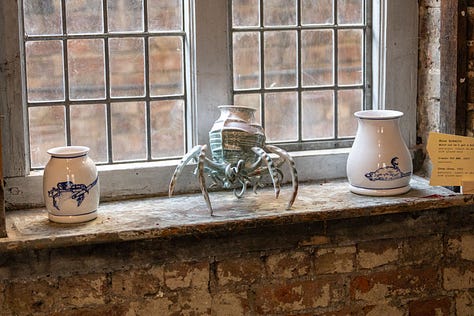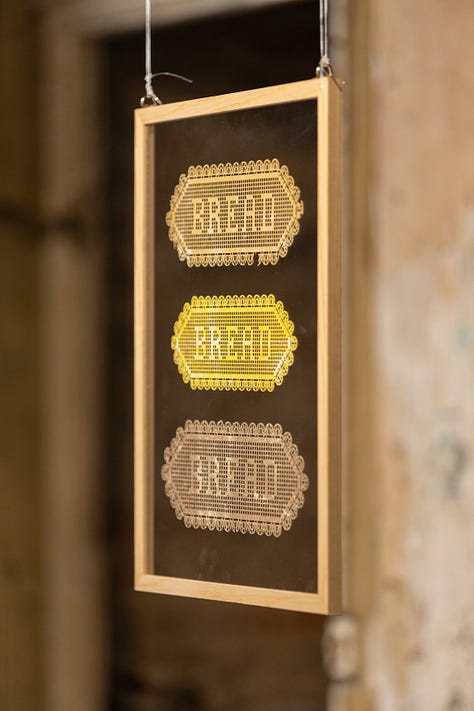BitterSweet reviews... Burn the Sheets
E.K. Myerson reviews Burn the Sheets: an exhibition of trans domesticities, at House of Annetta, E1 6QH, 23 May to 15 June 2025
Last month I moved in with my girlfriend; we spent the bank holiday weekend building Ikea furniture and, instead of going out to Unfold, we drank red wine and watched I Kissed a Boy with our kitten. So, yes, trans domesticity is on my mind at the moment.
If trans people (often) need to adapt the body to make it a home, then what do we have to do to a home to make it hold our bodies? And what adaptations are possible (to either: home or body) with the UK in its current state?
House of Annetta was customised relentlessly – its historic layers stripped back and reinvented – by its former owner, the Swiss activist, apiarist and cybernetician Annetta Pedretti. At the time of her death the project was unfinished: cracked floorboards, chipped bricks, no heating. The curation engages with these qualities of the house: custom fabric, printed with photographs of the peeling wallpaper and bricks (designed by Marf Summers), is tacked around plywood window seats and balustrades, interventions which allow the edges of the room to be used. The space is the ideal environment for this show, which exposes the fault lines in any current attempt at trans-normativity.

The paradox of trans domesticity is evident, for example, in Summers’ Bread Doilies: finely cut used sandpaper pieces which simultaneously emulate and reject softness. The disjuncture between form and material is tender, funny – and speaks to queer histories of homemaking, DIY dyke aesthetics.
My girlfriend and I can nest but our home isn’t ours – I’m reminded of that whenever I read the news. I left my last flat because our landlord issued a Section 21 eviction notice – the ‘no fault clause’ which is soon to be illegal under the Renters Reform bill. I can’t complain: I could afford to find this new place, we could afford to emigrate if we had to.
The dual crises of landlordism and state legislation are the contexts against which these eight established and emergent trans artists articulate their varied (re-)imaginings of the domestic.
As I walk through the show, I am taken with the variety of traditional techniques on display, drawn from applied and vernacular arts: ceramics, knitting, lacemaking, smocking, beadwork, sewing, folksong. Through the deployment of these forms, I think, the exhibition constructs an idea of an inhabitable past.
The exhibition feels lived in, invites rest. In Sam Godfrey’s three familiar waters, discarded curtain rails are bent into a circle: the hand-dyed fabric catches and diffuses the light so that it falls softly into the room. The resident cat of HoA sometimes sits inside the installation.



The act of making is often made visible; as in the needles hanging from the unfinished edges of Pear Nuallak’s Anti-Chinoiserie; or in Lou Lou Sainsbury’s film A Fantastic Body, in which the artist performs mysterious surgery by hand on a felted, medieval-esque puppet (Sunbeam). The suture, the scar, is a recurrent theme.
There are other medical and erotic signals to trans embodiment: silver oestradiol gel wrappers, like gum packets, are scattered in the plush interior of an antique cabinet in Sainsbury’s To the pain in the womb o womb womb womb fleshy womb; a silicone bird emerges from an O-ring in Summers’ A Song; a couple brush each other’s teeth with a double-headed toothbrush in Chole Swords & Jory Cherry’s film Toothbrushes – Onions, Beer.
These allusive, complex artworks are intently political but not explicitly polemic, demanding that the viewer exists in the space between answers: that is, the trans condition of irresolution. Don’t miss this show.
— E.K. Myerson
EK Myerson is an artist & critic. They recently completed their graduate diploma at the RCA. EK explores trans*materiality, alchemy, Arab-Jewish histories & disposable archives, through film, text, sculpture, photography & drawing. Before shifting to practice, EK was working as a medievalist. Their first book, The Desire for Syria in Medieval England, is forthcoming with Cambridge University Press. They received a Wellcome Trust Grant for their project on Derek Jarman’s response to medieval medicine during the AIDS crisis. Their essay-film, submerged reliquary of a Kentish saint (produced by the Jarman Lab; made with Sophie Mei Birkin & Bartek Dziadosz), was premiered at Birkbeck Institute of the Moving Image in 2022.

